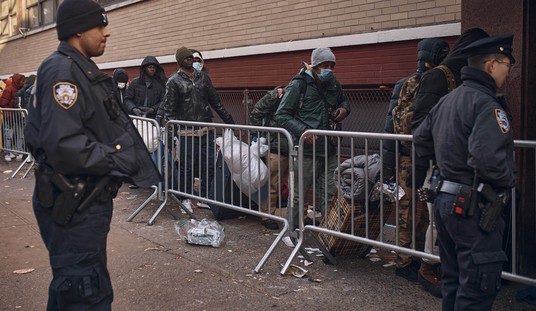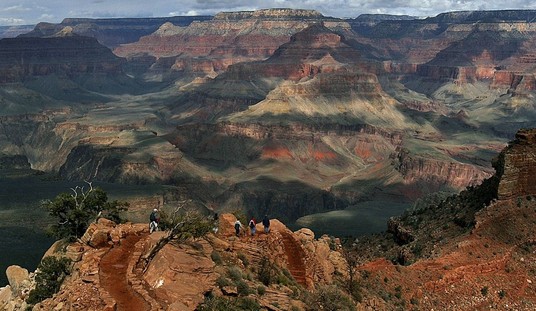Jazz pointed out yesterday that Israel seemed to be preparing to flood the so-called Gaza Metro, the tunnels that Hamas uses to hide themselves and the hostages from Israel. Today, it seems they are moving forward with the plan.
The IDF has officially decided to flood the tunnels in Gaza. It will start doing so gradually so that it can control any side effects and so Hamas can remove hostages from there in time before they collapse. pic.twitter.com/hkzqiiPEGN
— Shaiel Ben-Ephraim (@academic_la) December 5, 2023
Here’s a view of the supply pipes out to the sea.
🇵🇸🇮🇱 – A picture of Israeli soldiers from the Gaza beach, where they're preparing to attempt to flood the resistance tunnels with seawater. pic.twitter.com/NQV0EJZ43o
— War Watch (@WarWatchs) December 5, 2023
And this is apparently the first clip of the tunnels being flooded.
From the other side. 💙🌊🇮🇱 pic.twitter.com/mdcwwCHHZj
— Rubi Yona 💙🇮🇱 רובי יונה (@RubiYona) December 5, 2023
The first time I saw this suggested was about a month ago (I wrote about Israel’s options, including this one, here). Here’s the argument the author made:
The Gaza tunnel system, mostly constructed over the last forty years, provides Hamas with offensive access to Israel. It also constitutes the terrorist organization’s most formidable defensive redoubt. The tunnels present by far the most difficult logistical problem for Israel in eliminating enemy targets. Open-source maps show at least eleven independent tunnel networks, some nearly adjacent to the sea. The number of independent networks, however, could far exceed that. Hamas claims that the total length of the tunnels is about three hundred miles.
The geography of Gaza argues strongly for the stratagem of flooding the tunnels. It would force the enemy above ground where they can more easily be destroyed, dramatically reduce the Israeli casualties required to accomplish that task and resolve the problem of dealing with parts of the tunnels that are too deep to destroy through bombing. Most importantly, flooding is a permanent or near-permanent solution to the Gaza tunnel problem. Once accomplished, pumping them out enough to be usable again would be both extremely costly and—especially in conjunction with bombing—exceptionally difficult.
So that’s two big advantages. One, you can deal with the really deep tunnels that airpower can’t damage and two, once flooded the tunnels can just stay that way which means Hamas can’t move back in the moment Israel leaves Gaza. As you can see above, it takes a pretty big operation on the surface to pump the water into the tunnels. Any similar sized operation to empty them would be easy to destroy with airpower.
The author of that piece also pointed out this has been done before in 2015 when Egypt wanted to shut down smuggling tunnels into their territory.
On a humid night in Rafah recently, six Palestinian smugglers sat around a backyard table, ticking off the damage that Egypt has done to their tunnels over the past two years.
It dropped dynamite and floated poison gas into them. It filled them with sewage.
Last year, it took the extraordinary step of razing more than 3,000 homes on its side of the border to create a buffer zone that would seal off access to the tunnels, creating a humanitarian catastrophe in the process.
Now, the smugglers fear that Egypt has settled on a strategy that could spell doom for their trade: flooding the tunnels so they collapse. Within the past month, Egypt has flooded part of the nine-mile border area twice, causing two tunnels to cave in completely and damaging 10 or so more.
What about the hostages who are still being held by Hamas. No doubt they are in the tunnels too. But as the author argued, you don’t need to fill the uppermost tunnels all the way to the point that everyone inside drowns.
A six-by-five-foot tunnel that runs 300 miles is a huge volume to fill, but how fast it fills depends on how fast the water is pumped. Rough calculations indicate that if a single pipe were used for each of eleven tunnels, with each pipe pumping at a very conservative 100 gallons per minute, it would take about seven and a half months for all eleven tunnel networks to fill. Pumping water at ten times that rate, however, is routinely done today everywhere from wastewater treatment plants to oil field operations. Also, the tunnels wouldn’t have to be filled to capacity to generate the desired effect. The effect would begin as soon as water started to flow; by the time a tunnel has two or three feet of water it would be effectively unusable.
A former IDF officer made a similar point in an interview today. You only need to fill the tunnels enough that staying in them becomes suicidal and then you’ll see Hamas come out to the surface where Israel can confront them in a straight fight. The officer was asked about hostages and pointed out that bombing the tunnels is even more likely to result in accidentally harming hostages than flooding which can be controlled to some degree.
'It's to use natural force in order to get the tunnels or the whole metro system to become unstable, to force Hamas to go outside'
Frmr. IDF Officer from the Combat Engineering unit Achiya Klein breaks down the reports of IDF plans to flood #Gaza terror tunnels with seawater pic.twitter.com/3rPFRk5Av7
— i24NEWS English (@i24NEWS_EN) December 5, 2023
Of course this whole situation is only happening because of Hamas. There’s no way to guarantee what they’ll do when their hideout is flooded. Maybe they’ll execute the hostages and blame Israel. But this approach also seems to be one that will have the fewest civilian casualties, since as we all know the tunnels are only for Hamas fighters not for Gazan civilians who were not allowed to use them as shelters.
Finally, someone pointed out the irony of this potentially being the end of Hamas’ “Al Aqsa Flood” operation:
🚨 Breaking: First photos of Israel military pumping seawater to flood Hamas' tunnel network 👇
Hamas called the October 7th massacre “Flood of Al Aqsa" operation. They wanted flood, they'll get flood 🌊 pic.twitter.com/9gE5ZAb3Rj
— Dr. Eli David (@DrEliDavid) December 5, 2023
Update 12/6: Not much more about this today but I did see this. Apparently Israel is dropping leaflets with a verse from the Koran.
Israeli forces are flooding Gaza’s tunnel system with seawater—a crime with devastating consequences on the urban infrastructure. As they do this, their airplanes dropped leaflets quoting the Quran, “and the flood seized them…” We are dealing with genocidal fanatics. pic.twitter.com/zXIJoDODuv
— Mohammed El-Kurd (@m7mdkurd) December 6, 2023








Join the conversation as a VIP Member